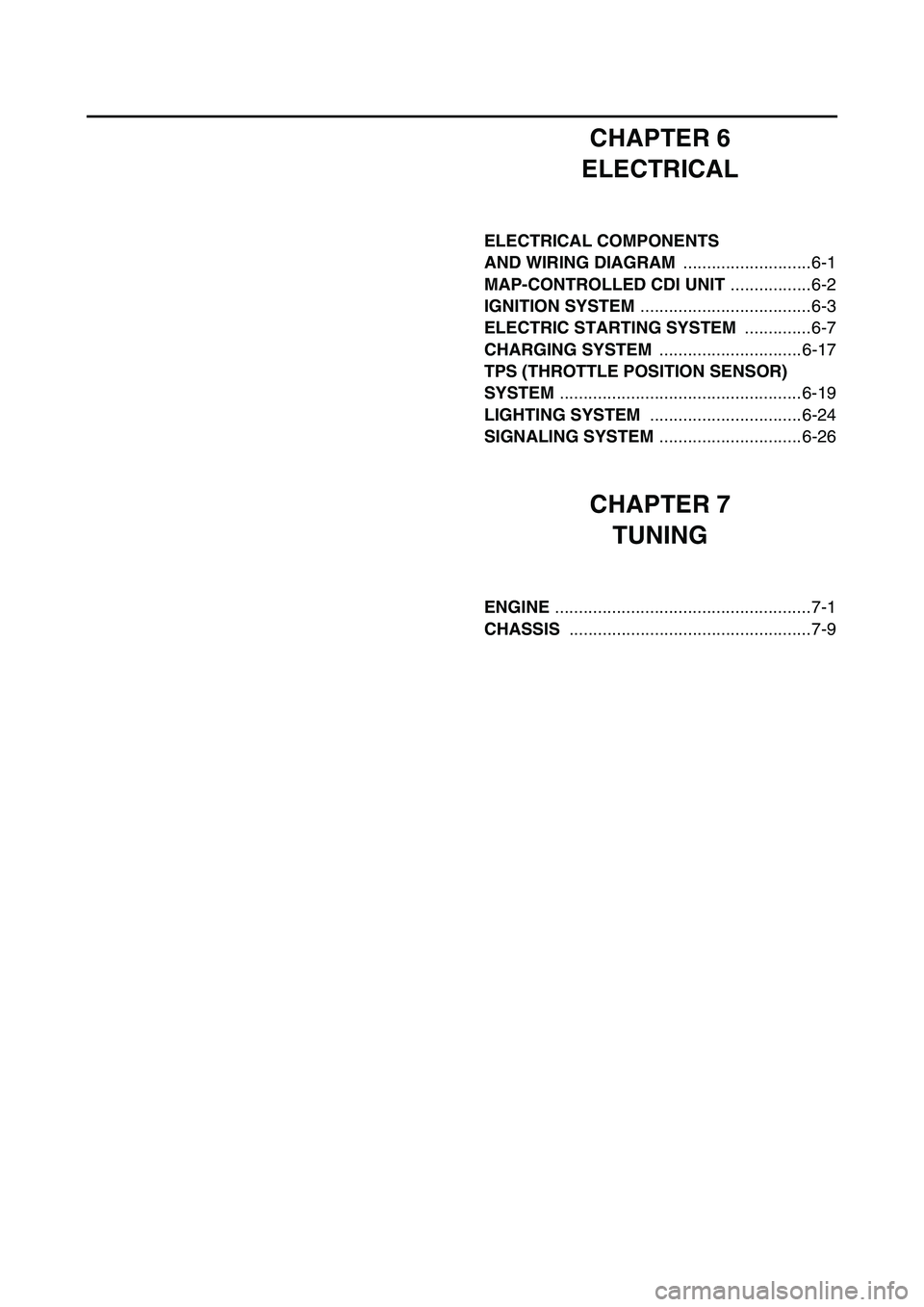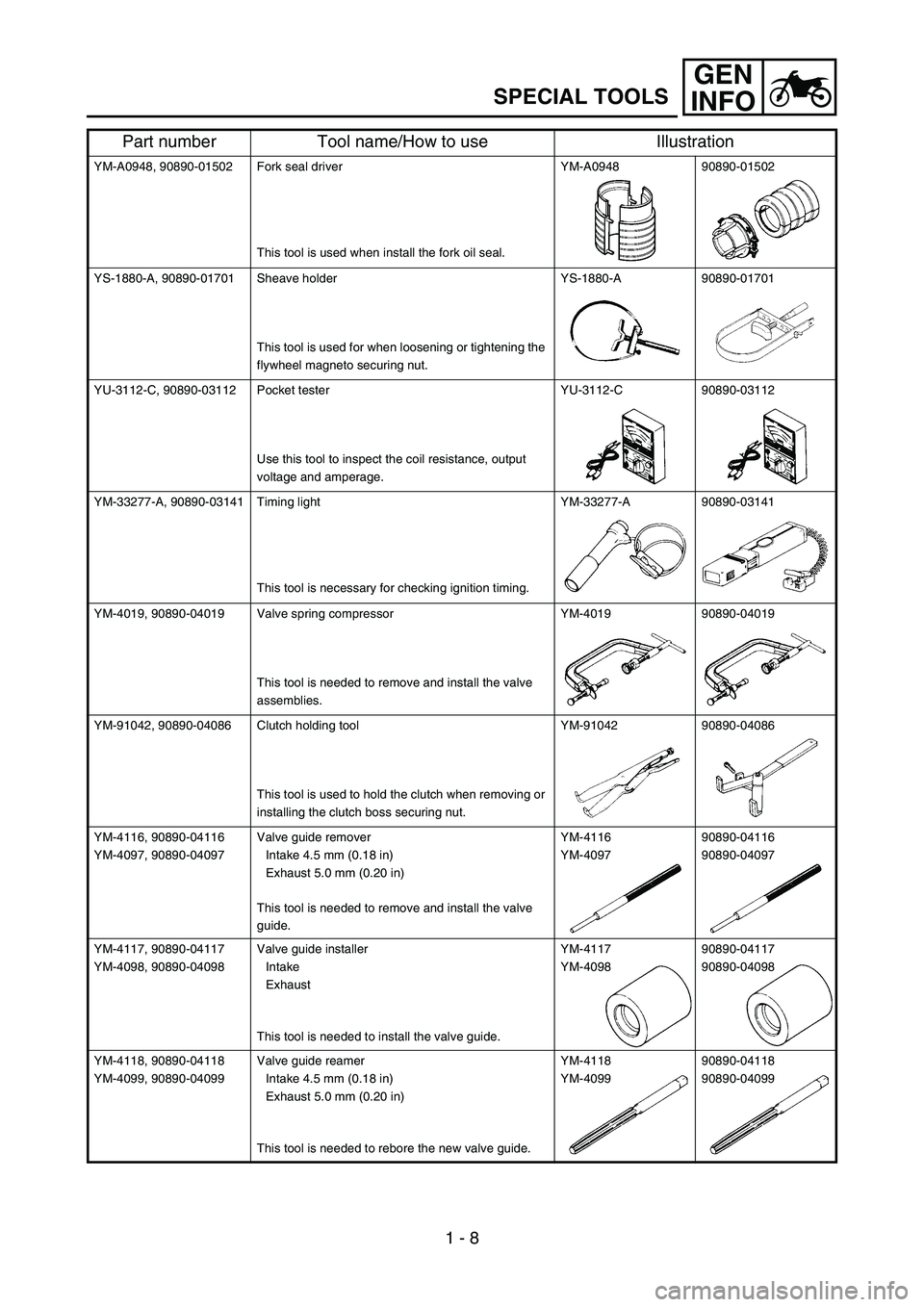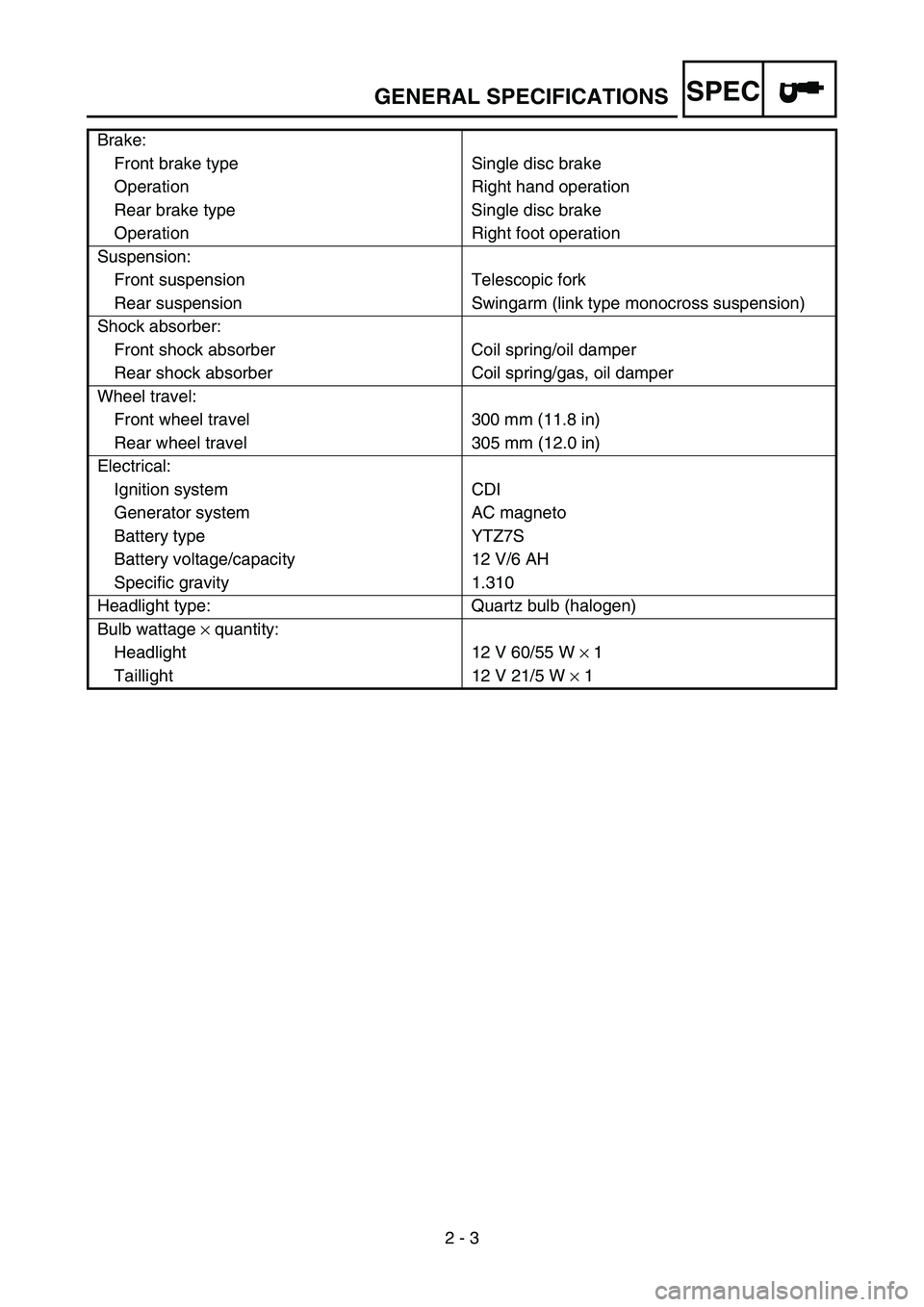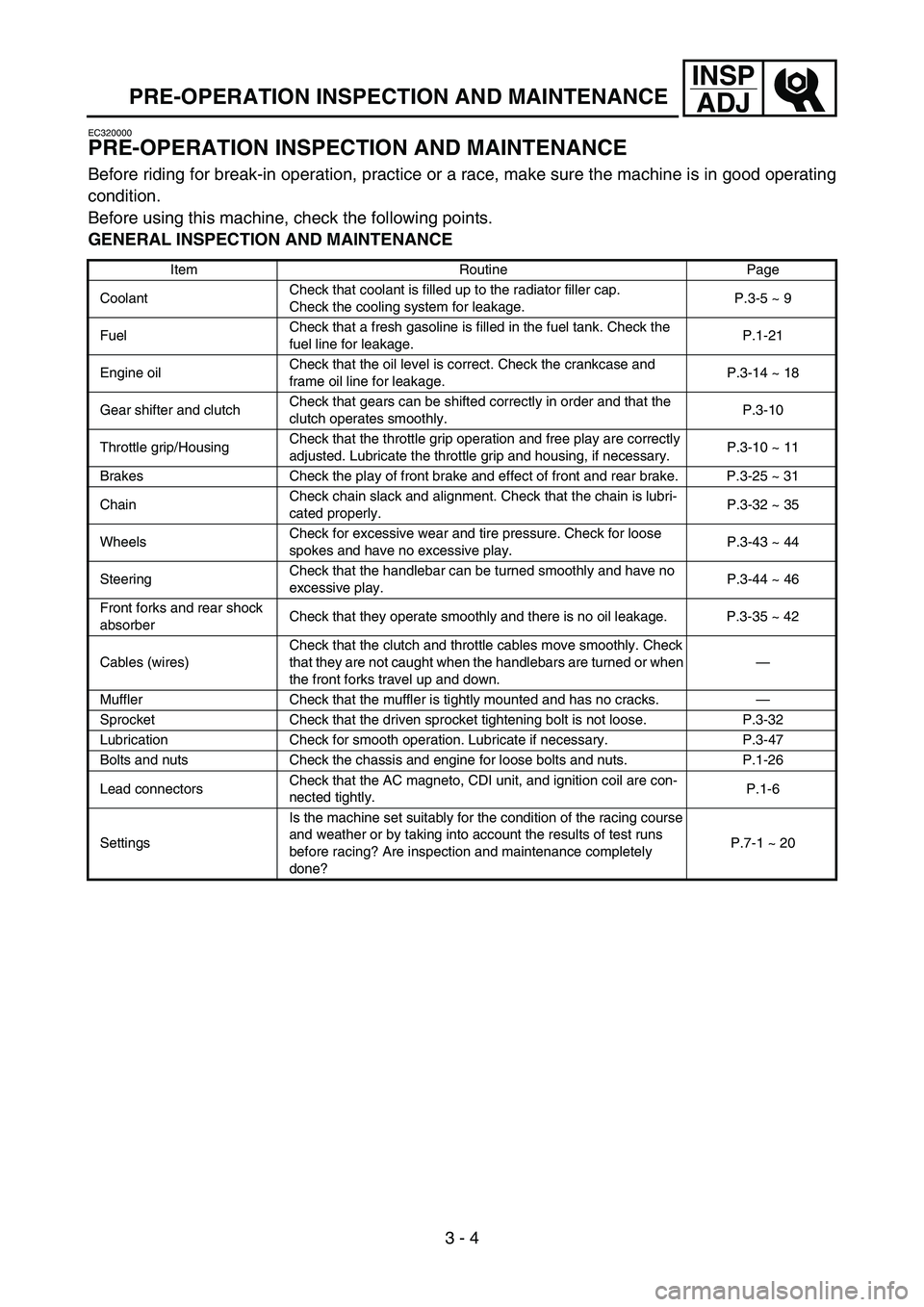ignition YAMAHA WR 450F 2006 Owners Manual
[x] Cancel search | Manufacturer: YAMAHA, Model Year: 2006, Model line: WR 450F, Model: YAMAHA WR 450F 2006Pages: 786, PDF Size: 22.49 MB
Page 24 of 786

CHAPTER 6
ELECTRICAL
ELECTRICAL COMPONENTS
AND WIRING DIAGRAM ...........................6-1
MAP-CONTROLLED CDI UNIT .................6-2
IGNITION SYSTEM ....................................6-3
ELECTRIC STARTING SYSTEM ..............6-7
CHARGING SYSTEM ..............................6-17
TPS (THROTTLE POSITION SENSOR)
SYSTEM ...................................................6-19
LIGHTING SYSTEM ................................6-24
SIGNALING SYSTEM ..............................6-26
CHAPTER 7
TUNING
ENGINE ......................................................7-1
CHASSIS ...................................................7-9
Page 39 of 786

GEN
INFO
1 - 8
SPECIAL TOOLS
YM-A0948, 90890-01502 Fork seal driver
This tool is used when install the fork oil seal.YM-A0948 90890-01502
YS-1880-A, 90890-01701 Sheave holder
This tool is used for when loosening or tightening the
flywheel magneto securing nut.YS-1880-A 90890-01701
YU-3112-C, 90890-03112 Pocket tester
Use this tool to inspect the coil resistance, output
voltage and amperage.YU-3112-C 90890-03112
YM-33277-A, 90890-03141 Timing light
This tool is necessary for checking ignition timing.YM-33277-A 90890-03141
YM-4019, 90890-04019 Valve spring compressor
This tool is needed to remove and install the valve
assemblies.YM-4019 90890-04019
YM-91042, 90890-04086 Clutch holding tool
This tool is used to hold the clutch when removing or
installing the clutch boss securing nut.YM-91042 90890-04086
YM-4116, 90890-04116
YM-4097, 90890-04097Valve guide remover
Intake 4.5 mm (0.18 in)
Exhaust 5.0 mm (0.20 in)
This tool is needed to remove and install the valve
guide.YM-4116
YM-409790890-04116
90890-04097
YM-4117, 90890-04117
YM-4098, 90890-04098Valve guide installer
Intake
Exhaust
This tool is needed to install the valve guide.YM-4117
YM-409890890-04117
90890-04098
YM-4118, 90890-04118
YM-4099, 90890-04099Valve guide reamer
Intake 4.5 mm (0.18 in)
Exhaust 5.0 mm (0.20 in)
This tool is needed to rebore the new valve guide.YM-4118
YM-4099 90890-04118
90890-04099
Part number Tool name/How to use Illustration
Page 40 of 786

GEN
INFO
1 - 9
SPECIAL TOOLS
YM-04142, 90890-04142 Rotor puller
This tool is used to remove the flywheel magneto.YM-04142 90890-04142
YM-34487
90890-06754Dynamic spark tester
Ignition checker
This instrument is necessary for checking the ignition
system components.YM-34487 90890-06754
YB-35956-A, 90890-06756 Vacuum/pressure pump gauge set
This tool is used to check the air induction system.YB-35956-A 90890-06756
ACC-QUICK-GS-KT
90890-85505Quick gasket
YAMAHA Bond No. 1215
This sealant (Bond) is used for crankcase mating sur-
face, etc.ACC-QUICK-GS-KT 90890-85505
Part number Tool name/How to use Illustration
Page 74 of 786

1 - 22
GEN
INFO
STARTING AND BREAK-IN
STARTING AND BREAK-IN
WARNING
Never start or run the engine in a closed
area. The exhaust fumes are poisonous;
they can cause loss of consciousness and
death in a very short time. Always operate
the machine in a well-ventilated area.
CAUTION:
The carburetor on this machine has a
built-in accelerator pump. Therefore,
when starting the engine, do not operate
the throttle or the spark plug will foul.
Unlike a two-stroke engine, this engine
cannot be kick started when the throttle is
open because the kickstarter may kick
back. Also, if the throttle is open the air/
fuel mixture may be too lean for the
engine to start.
Before starting the machine, perform the
checks in the pre-operation check list.
AIR FILTER MAINTENANCE
According to “AIR FILTER CLEANING” section
in the CHAPTER 3, apply the foam-air-filter oil
or its equivalent to the element. (Excess oil in
the element may adversely affect engine start-
ing.)
STARTING A COLD ENGINE
NOTE:
This model is equipped with an ignition circuit
cut-off system. The engine can be started
under the following conditions.
When the transmission is in neutral.
When the clutch is disengaged with the
transmission in any position. However, it is
recommended to shift into neutral before
starting the engine.
1. Inspect the coolant level.
2. Turn the fuel cock to “ON”.
3. Push the main switch to “ON”.
4. Shift the transmission into neutral.
5. Fully open the cold starter knob 1.
6. Start the engine by pushing the start switch
or by kicking the kickstarter.
Page 92 of 786

SPEC
2 - 3 Brake:
Front brake type Single disc brake
Operation Right hand operation
Rear brake type Single disc brake
Operation Right foot operation
Suspension:
Front suspension Telescopic fork
Rear suspension Swingarm (link type monocross suspension)
Shock absorber:
Front shock absorber Coil spring/oil damper
Rear shock absorber Coil spring/gas, oil damper
Wheel travel:
Front wheel travel 300 mm (11.8 in)
Rear wheel travel 305 mm (12.0 in)
Electrical:
Ignition system CDI
Generator system AC magneto
Battery type YTZ7S
Battery voltage/capacity 12 V/6 AH
Specific gravity 1.310
Headlight type: Quartz bulb (halogen)
Bulb wattage × quantity:
Headlight 12 V 60/55 W × 1
Taillight 12 V 21/5 W × 1
GENERAL SPECIFICATIONS
Page 107 of 786

SPEC
2 - 18
EC212300
ELECTRICAL
Item Standard Limit
Ignition system:
Advancer type Electrical ----
C.D.I.:
Pickup coil resistance (color) 248 ~ 372 Ω at 20 °C (68 °F)
(White – Red)----
CDI unit-model/manufacturer 5TJ-B0/YAMAHA (For USA)
5TJ-C0/YAMAHA
(Except for USA)----
----
Ignition coil:
Model/manufacturer 5TA-10/DENSO ----
Minimum spark gap 6 mm (0.24 in) ----
Primary winding resistance 0.08 ~ 0.10 Ω at 20 °C (68 °F) ----
Secondary winding resistance 4.6 ~ 6.8 kΩ at 20 °C (68 °F) ----
Charging system:
System type AC magneto ----
Model (stator)/manufacturer 5TJ 30/YAMAHA ----
Normal output 14 V/120 W at 5,000 r/min ----
Charging coil resistance (color) 0.288 ~ 0.432 Ω at 20 °C (68 °F)
(White – Ground)----
Lighting coil resistance (color) 0.224 ~ 0.336 Ω at 20 °C (68 °F)
(Yellow – Ground)----
Rectifier/regulator:
Regulator type Semiconductor short circuit ----
Model/manufacture SH712AC/SHINDENGEN ----
Regulated voltage (AC) 13.0 ~ 14.0 V ----
Regulated voltage (DC) 14.1 ~ 14.9 V ----
Rectifier capacity (AC) 12 A ----
Rectifier capacity (DC) 8 A ----
Electric starting system:
Type Constant mesh ----
Starter motor:
Model/manufacturer 5TJ10/YAMAHA ----
Operation voltage 12 V ----
Output 0.48 kW ----
Armature coil resistance 0.0117 ~ 0.0143 Ω at 20 °C
(68 °F)----
Brush overall length 7 mm (0.28 in) 3.5 mm
(0.14 in)
Brash quantity 2 pcs. ----
Spring force 3.92 ~ 5.88 N
(400 ~ 600 g, 14.1 ~ 21.2 oz)----
Commutator diameter 17.6 mm (0.69 in) 16.6 mm
(0.65 in)
Mica undercut (depth) 1.5 mm (0.06 in) ----
MAINTENANCE SPECIFICATIONS
Page 178 of 786

2 - 25
SPECCABLE ROUTING DIAGRAM
1Hot starter cable
2Clutch cable
3Throttle cable (return)
4Throttle cable (pull)
5Ignition coil
6Negative battery lead
7Starter motor lead
8Coolant reservoir tank breather
hose
9Cable holder
0Coolant reservoir hose
AClamp
BCDI unit lead
CCDI unit
DCDI unit band
ECDI unit stay (frame)
FCable bracketÈPass the throttle cables, clutch
cable and hot starter cable
through the cable guides.
ÉPass the throttle cables, clutch
cable and hot starter cable
between the radiator and frame,
then over the middle radiator
mounting boss.
ÊPass the throttle cables and
clutch cable on the outside of
the ignition coil.
ËPass the carburetor breather
hose (throttle cable cover)
through the hose holder.
ÌFasten the coolant reservoir
tank breather hose and carbure-
tor breather hoses together with
a plastic locking tie.ÍFasten the grommet of the clutch
cable with the cable holder.
ÎFasten the CDI unit lead to the
frame with a plastic locking tie
ends at the lower of the frame
and cut off the tie end.
ÏInsert the CDI unit band over the
CDI unit stay (frame) as far as
possible.
ÐFasten the starter motor lead
and negative battery lead to the
cable bracket in its slot with a
plastic locking tie and cut off the
tie end.
A
A
D
ÏE A
Ð
B
B
C
F
Í90
ÎABCD
1
2
43
È
É
Ê
5
6 7 8 Ë Ì
Page 200 of 786

3 - 4
INSP
ADJ
PRE-OPERATION INSPECTION AND MAINTENANCE
EC320000
PRE-OPERATION INSPECTION AND MAINTENANCE
Before riding for break-in operation, practice or a race, make sure the machine is in good operating
condition.
Before using this machine, check the following points.
GENERAL INSPECTION AND MAINTENANCE
Item Routine Page
CoolantCheck that coolant is filled up to the radiator filler cap.
Check the cooling system for leakage.P.3-5 ~ 9
FuelCheck that a fresh gasoline is filled in the fuel tank. Check the
fuel line for leakage.P.1-21
Engine oilCheck that the oil level is correct. Check the crankcase and
frame oil line for leakage.P.3-14 ~ 18
Gear shifter and clutchCheck that gears can be shifted correctly in order and that the
clutch operates smoothly.P.3-10
Throttle grip/HousingCheck that the throttle grip operation and free play are correctly
adjusted. Lubricate the throttle grip and housing, if necessary.P.3-10 ~ 11
Brakes Check the play of front brake and effect of front and rear brake. P.3-25 ~ 31
ChainCheck chain slack and alignment. Check that the chain is lubri-
cated properly.P.3-32 ~ 35
WheelsCheck for excessive wear and tire pressure. Check for loose
spokes and have no excessive play.P.3-43 ~ 44
SteeringCheck that the handlebar can be turned smoothly and have no
excessive play.P.3-44 ~ 46
Front forks and rear shock
absorberCheck that they operate smoothly and there is no oil leakage. P.3-35 ~ 42
Cables (wires)Check that the clutch and throttle cables move smoothly. Check
that they are not caught when the handlebars are turned or when
the front forks travel up and down.—
Muffler Check that the muffler is tightly mounted and has no cracks.—
Sprocket Check that the driven sprocket tightening bolt is not loose. P.3-32
Lubrication Check for smooth operation. Lubricate if necessary. P.3-47
Bolts and nuts Check the chassis and engine for loose bolts and nuts. P.1-26
Lead connectorsCheck that the AC magneto, CDI unit, and ignition coil are con-
nected tightly.P.1-6
SettingsIs the machine set suitably for the condition of the racing course
and weather or by taking into account the results of test runs
before racing? Are inspection and maintenance completely
done?P.7-1 ~ 20
Page 230 of 786

3 - 18
INSP
ADJ
IDLE SPEED ADJUSTMENT
10. Install:
Oil filler plug
11. Inspect:
Engine (for oil leaks)
Oil level
Refer to “ENGINE OIL LEVEL INSPEC-
TION”.
12. Check:
Oil pressure
EC35M021
IDLE SPEED ADJUSTMENT
1. Start the engine and thoroughly warm it up.
2. Adjust:
Idle speed Checking steps:
Slightly loosen the oil gallery bolt 1.
Start the engine and keep it idling until oil
starts to seep from the oil gallery bolt. If no
oil comes out after one minute, turn the
engine off so it will not seize.
Check oil passages, oil filter and oil pump
for damage or leakage.
Start the engine after solving the prob-
lem(s) and recheck the oil pressure.
Tighten the oil gallery bolt to specification.
T R..
Oil gallery bolt:
10 Nm (1.0 m kg, 7.2 ft lb)
Adjustment steps:
Turn the throttle stop screw 1 until the
specified engine idling speed.
NOTE:
Using a digital engine tachometer for idle
speed adjustment, detect the engine idling
speed by bringing the sensing element c of
the engine tachometer close to the ignition
coil 2.
To increase idle speed
→
Turn the throttle stop screw
1 in
a.
To decrease idle speed
→
Turn the throttle stop screw
1 out
b.
Engine idling speed:
1,700 ~ 1,900 r/min
c2
Page 294 of 786

3 - 49
INSP
ADJ
IGNITION TIMING CHECK
IGNITION TIMING CHECK
1. Remove:
Timing plug 1
1
2. Attach:
Timing light
Inductive tachometer
To the ignition coil lead (orange lead 1).
Timing light:
YM-33277-A/90890-03141
1
3. Adjust:
Engine idling speed
Refer to “IDLE SPEED ADJUSTMENT”.
4. Check:
Ignition timing
Visually check the stationary pointer a is
within the firing range b on the rotor.
Incorrect firing range → Check rotor and
pickup assembly.
5. Install:
Timing plug